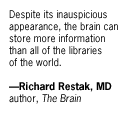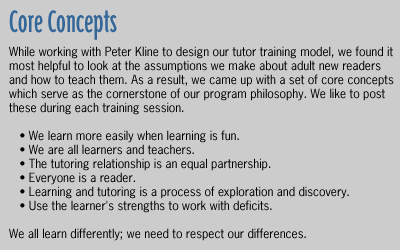|

 Learning
is a natural process, like breathing in and out. We do it all
the time, but don't realize it because it is unconscious, easy,
and part of our daily lives. However, if we asked you to describe
a recent attempt to learn something new-perhaps a new computer
program or how to change the oil in your car-it's quite possible
you would describe at least part of the process as hard work or
frustrating. Why the disparity? Perhaps we have come to think
of learning something new as work, while exploring a new interest
is fun. Learning can be challenging, especially if in an area
that is unfamiliar terrain or just doesn't make sense. Learning
is a natural process, like breathing in and out. We do it all
the time, but don't realize it because it is unconscious, easy,
and part of our daily lives. However, if we asked you to describe
a recent attempt to learn something new-perhaps a new computer
program or how to change the oil in your car-it's quite possible
you would describe at least part of the process as hard work or
frustrating. Why the disparity? Perhaps we have come to think
of learning something new as work, while exploring a new interest
is fun. Learning can be challenging, especially if in an area
that is unfamiliar terrain or just doesn't make sense.
However, it is the premise of innovative educators
like Peter Kline that each of us is an "everyday genius," that
we have a great capacity to learn. The key to unlocking that capacity
is to create an environment that supports discovery and allows
us to enjoy learning because our natural talents are being used
more successfully.
One of the best ways to understand how we learn
is to observe infants and young children. Kline describes the
process in this way:
Born with a mental structure that organizes
the sounds of spoken words into complex grammatical forms, the
child builds a language without anyone's instruction. All he needs
is to listen to these sounds and then try them out...We came into
the world instinctively prepared to do two things. One was to
suck nourishment from our mother's breasts. To accomplish this
we used our sucking instinct. The other was to do everything else.
To accomplish this we used our learning instinct.
 If
we watch children interact with their world, their entire experience
is one of learning-through tasting, smelling, crawling, handling,
talking and listening. They are totally engaged in this exploring. If
we watch children interact with their world, their entire experience
is one of learning-through tasting, smelling, crawling, handling,
talking and listening. They are totally engaged in this exploring.
As we grow up and attend school, many of our
ways of gathering information are taken away. We are told to sit
still, be quiet, stop daydreaming, not to doodle and pay attention.
For the child who learns best by moving around, we have taken
away his or her primary mode of learning. For the interactive
learner who needs to talk about ideas to understand them, we have
taken away the ability to integrate information.
For the child who understands best by drawing
diagrams and symbols, she or he loses that most vital tool. Although
music is used to teach the ABC's in elementary school, it is considered
too childish to use in the higher grades. Before we know it, learning
becomes boring or school becomes a challenge to meet without our
full sot of tools. The joy is gone.
School programs and educational techniques
reflect our western values which elevate science, math, and logical
achievement above success in the arts and human relations fields.
Schools teach most effectively to those with strong language and
logical thinking skills. If you were successful in school, you
arc probably strong in these areas. Yet your learner may not be.
Those who learn differently are often misunderstood, neglected,
or undeserved by our educational systems.
Studies of the brain have shown that we need
to move, sing, dance, draw, talk, and reflect to learn effectively.
So the first thing we need to let go of is the expectation that
there is one "right" way to learn or teach. Secondly, we need
to let go of the expectation that our learners will be most successful
if they use the same strategies that worked for us. Diversity
is the key.
Instead, let your tutoring be a discovery process.
Find out what excites you. Find out what excites your learner.
Work together to create lessons. Your learner will often know
better than you what works for him or her This can make the entire
process interesting and fun.

Studies of exceptional learners and "geniuses"
have provided clues on how to improve our learning process. These
findings have been used to develop strategies for successful learning.
Research has shown that geniuses:
- See more, take in, and process more stimuli
- Make a wide variety of associations
- Have the ability to think rapidly
- See the nonevident as well as the evident
- Think independently, engage in self-reflection
- Daydream more
- Have a sense of well-being
How do we create an environment that allows
our "natural genius" to blossom? That is the challenge for both
tutor and learner. One of the first things we can do is recognize
our different ways of learning.
Next section:
About this site
|